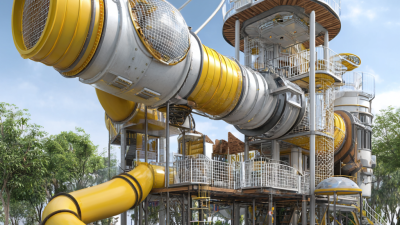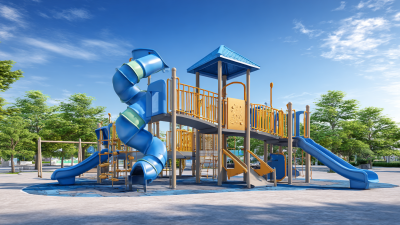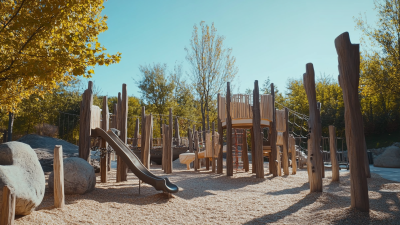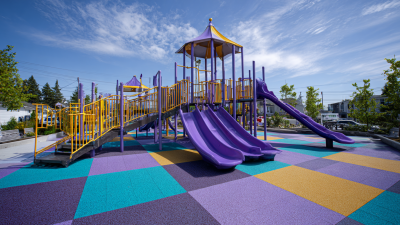
Inquiry
Form loading...
The increasing interest in children's health and development has led to a surge in the popularity of Commercial Indoor Playground Equipment, which plays a pivotal role in fostering physical activity and social interactions among young children. According to a recent report by the International Play Equipment Manufacturers Association (IPEMA), a well-designed indoor playground can not only enhance physical fitness but also improve social skills and emotional health, addressing the growing concerns of childhood obesity and sedentary lifestyles.

The Centers for Disease Control and Prevention (CDC) emphasizes that regular physical activity helps mitigate health risks, and incorporating playtime into daily routines can significantly benefit children's overall development. Moreover, with the indoor playground industry projected to grow at a rate of 9% annually through 2025, the demand for high-quality, safe, and engaging Commercial Indoor Playground Equipment is more crucial than ever. This exploration into the multifaceted advantages of such facilities will illuminate the instrumental role they play in shaping healthier, more active futures for children.
When it comes to commercial indoor playground equipment for children, there is a vast array of options that cater to different age groups and developmental needs. These structures are designed not only for fun but also to promote physical activity, social interaction, and cognitive development. Common types of equipment include climbing walls, ball pits, slides, and obstacle courses, each offering unique ways for children to engage in play while enhancing their gross motor skills.
In addition to these traditional playground staples, modern indoor facilities often feature more innovative installations such as interactive games and sensory play areas. These elements encourage children to explore, solve problems, and cooperate with their peers, fostering teamwork and communication skills. Furthermore, the inclusion of soft play equipment ensures safety while allowing children to freely express themselves in a stimulating environment. Overall, the variety of commercial indoor playground equipment available provides endless opportunities for children to learn and grow through play.
| Type of Equipment | Benefits | Age Group | Safety Features |
|---|---|---|---|
| Climbing Structures | Enhances physical strength and coordination | 2-8 years | Soft padding, safety nets |
| Slides | Encourages social interaction and fun | 3-10 years | Smooth edges, non-slip surfaces |
| Ball Pits | Improves sensory skills and balance | 1-5 years | Non-toxic balls, protective barriers |
| Swing Sets | Promotes physical fitness and motor skills | 2-10 years | Secure harnesses, stable frames |
| Activity Panels | Fosters cognitive development and creativity | Infants to 3 years | Sturdy construction, rounded edges |
Indoor playgrounds have emerged as vital spaces for children's physical development, offering unique benefits that facilitate active play. One key health benefit is the enhancement of motor skills. Engaging in various activities within these play areas, such as climbing, sliding, and balancing, helps children develop coordination, agility, and strength. These fundamental skills are critical during early childhood, laying the groundwork for more complex physical activities as they grow older.
Furthermore, indoor playgrounds promote cardiovascular health through sustained physical activity. Children often engage in energetic play for extended periods, which increases their heart rates and helps build endurance. This active lifestyle combats sedentary behaviors that can lead to obesity and other health issues. By integrating movement into play, indoor playgrounds encourage children to be active, fostering a routine of physical exercise that can carry over into their daily lives.
Indoor playgrounds have emerged as vital spaces for children to develop social skills through interactive play. Unlike traditional outdoor playgrounds, which can be limited by weather and space, commercial indoor playgrounds provide a controlled environment where kids can engage freely with their peers. This structured setting encourages group activities, fostering cooperation and teamwork among children. As they navigate through obstacle courses, engage in games, and participate in group challenges, children learn to communicate effectively, negotiate roles, and resolve conflicts, all essential components of social development.
Moreover, the diverse range of play equipment available in indoor playgrounds caters to various interests and abilities, allowing children to interact with a broader peer group. This exposure not only enhances their social networks but also teaches them empathy and understanding as they encounter different personalities and play styles. Parents often observe their children stepping out of their comfort zones, forming friendships, and growing more confident in social settings. Thus, indoor playgrounds play a critical role not just in physical development but also in cultivating strong social skills that will benefit children throughout their lives.

When selecting indoor playground equipment for children, safety features must be a primary consideration. One of the most important aspects is the material used in construction. Opt for playgrounds made from non-toxic, durable materials that can withstand heavy use while ensuring the health and safety of children. Additionally, equipment should have smooth edges and rounded corners to reduce the risk of cuts and bruises during play.
Another crucial safety feature is the presence of proper cushioning on the surfaces where children will play. Soft mats or padded areas can significantly minimize injuries from falls. Furthermore, ensure that the playground equipment is age-appropriate, with barriers or enclosures to prevent younger children from accessing areas that may be too advanced for them. Regular maintenance checks and secure installation are also fundamental to ensuring ongoing safety, making it essential to choose equipment from reputable manufacturers that prioritize these standards.
Maintaining and upgrading indoor playground equipment is essential for ensuring both the safety and longevity of the play environment. Regular inspections should be conducted to identify any signs of wear and tear, such as loose bolts, cracked panels, or worn floor mats. It’s crucial to address these issues promptly to prevent accidents and injuries. Additionally, using high-quality materials during maintenance can significantly enhance the durability of the equipment, further extending its lifespan.
Upgrading indoor play equipment can also provide various health and developmental benefits for children. Updating structures to incorporate new play trends, such as sensory play areas or climbing features, can enhance children's physical development and encourage imaginative play. Moreover, modernizing safety features, like soft barriers and cushioned flooring, creates a safer environment, reducing the risk of injuries. Investing in both maintenance and upgrades not only fosters a safe play space but also enriches the play experience, contributing positively to children's overall development.







